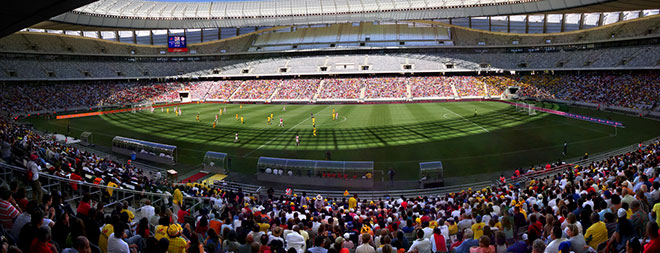Stadium Acoustics Pump Up the Volume

(ISNS) -- The roar of the crowd is a major part of the excitement of attending a sporting event. A noisy, engaged crowd makes for a better experience for fans, and is often credited with helping the players on the field, too.
"The players love it," said Carl Francis, director of communications for the NFL Players Association. "Fan support definitely has an impact on the players."
Stadium designers know this, and the new generation of stadiums now incorporate design features that help boost fan support by trapping and amplifying crowd noise. The most important aspects are to keep the size of the stadium as small as possible, and to provide reflecting surfaces that can turn the noise back to the crowd, said Jack Wrightson, a Dallas-based acoustical consultant who has worked on the design of dozens of athletic venues in North America.
"Sound loses energy as it travels, so the key is to keep the venue small and intimate," said Wrightson.
The San Francisco 49ers' new Levi's Stadium, in Santa Clara, Calif., has been designed with this in mind. It's small, and fits snugly into its dense urban location. One of the long sides of the oval has been truncated, with the media booths placed in a tower that reduces the footprint of the stadium and will help reflect sound back towards the fans when it opens later this year.
Using materials like wood and metal increases reverberations and can also boost crowd noise.
While most North American stadiums are open to the sky, having a roof can help amp up the noise in the stands. European soccer stadiums all have partial roofs, which helps keep noise levels up. At the Seattle Seahawks' CenturyLink Stadium the large overhanging roof reflects noise down towards the stands, and has helped the fans there – collectively and officially known as the 12th man – set the Guinness World Record for crowd noise, at an astounding 137.6 dBA, a decibel scale that accounts for how sensitive the human hearing system is to different sound frequencies.
Sign up for the Live Science daily newsletter now
Get the world’s most fascinating discoveries delivered straight to your inbox.
That level of noise is comparable to standing about 150 feet away from a jet engine during takeoff, and could potentially cause immediate, permanent hearing loss. But the risk to an individual depends on many factors, including how long a person is exposed, and how close they are to the source, said Jennifer Tufts, an audiologist at the University of Connecticut, in Storrs and past president of the National Hearing Conservation Association, a professional association whose mission is to prevent hearing loss in the work force and the general population.
"A ringing in your ears after you leave the game could indicate you were exposed to sound levels loud enough to potentially cause permanent damage," she said.
The National Institute for Occupational Safety and Health says that without protection, exposure to noise levels equivalent to 85 dBA for eight hours could lead to permanent damage over time. And for every 3 dB above that, the safe exposure time is cut in half. The noise in the stands during a football or soccer game could easily hover around 80-90 dBA, with higher spikes during exciting plays.
"If I were going to a game like that, I would wear hearing protection," said Tufts. "I'm an audiologist; I value my hearing. … I take earplugs everywhere."
People who go to a lot of games, as well as the players, referees and stadium staff would be most at risk, said Tufts, because damage is cumulative so even minor effects can build up over time. Francis said the NFLPA is becoming much more active in monitoring player safety, but for now doesn't have any specific rules or recommendations on noise levels or hearing protection.
"Crowd noise is not usually going to fall into the category of traumatic damage, but some people are more susceptible than others," said Tufts. So it's best to err on the side of caution; if it's loud enough in the stands that you have to shout to be heard, you should probably wear earplugs. And your ears need to rest after exposure. "The worst thing you could do after a game is go home and cut the lawn, or out to a noisy bar," she added.
In the end though, no matter what the architects do to enhance the atmosphere, the noise levels in a stadium depend on the fans themselves. The English soccer team Arsenal’s old stadium in Highbury, London was often derided as "Highbury the library" by opposing fans, who felt the home supporters lacked passion, while the Denver Broncos' old Mile High stadium was notoriously noisy, despite having nothing much to recommend it acoustically.
"It doesn't matter what you do to the building if the crowd doesn’t make noise," said Wrightson.
Inside Science News Service is supported by the American Institute of Physics. Brian Owens is a freelance science journalist in St. Stephen, New Brunswick, Canada.









